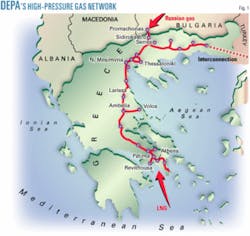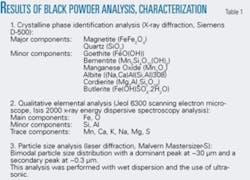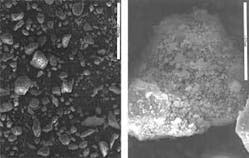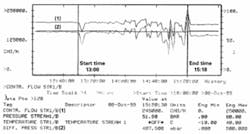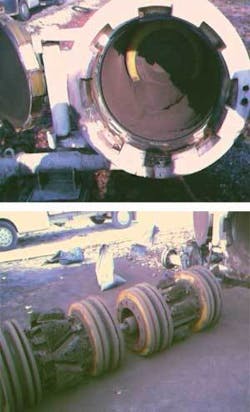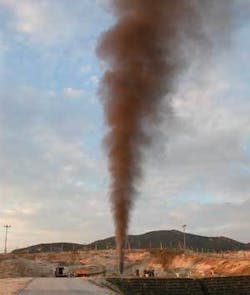Effective removal of black powder from a gas transmission system often requires a combination of methods. Removing such particulates is a multistep process requiring a comprehensive understanding of the nature of the problem. Different tools may be effective in some instances but not in others.
This article examines Greek Public Gas Corp. SA’s (DEPA’s) experience in fighting black powder in its system, focused on its determining which technique provided the most efficient and cost-effective method of powder removal.
Included in this examination are the different sorts of pigs, filters, and separators DEPA used in attempting to address the problem, with the effectiveness and shortcomings of each assessed.
Background
Black powder is a solid contaminant found in natural gas transmission and distribution systems throughout the world. Chemical or biological reactions with steel found in natural gas pipelines, gas wells, and associated facilities can create black powder.1 Solids may be simple or complex mixtures of small particles dispersed in gas (particulates) or they may be dispersed in water or liquid hydrocarbons (slurry).
Formation cuttings, drilling mud, desiccant dust, construction dirt, sand, mill scale, iron oxide, iron carbonate, iron sulphide, welding slag and splatter, eroded steel cuttings, salt crystals, valve grease, corrosion inhibitor, and other organic materials can all contribute to the presence of black powder.2
DEPA’s high-pressure gas network (Fig. 1) first experienced operational problems caused by black powder in imported natural gas in March 1999. DEPA performed a pigging operation on the first 12 km of the Greek pipeline from the Bulgarian-Greek border at Promachonas to the border metering station, removing 1,000 kg of powder.
Ongoing black-powder contamination of DEPA’s network increased gradually as gas offtakes increased. Powder gathering in the gas piping and installations resulted in:
- Reduced flow efficiencies.
- Clogged and collapsed filters.
- Deposits on gas measurement devices.
- Clogging of instrumentation and valves.
- Accelerated deterioration of valves due to erosion.
- Other operations, maintenance, and safety concerns.
Black powder, either attached to the pipe wall, or collected in the pipe bottom, increased roughness, decreased flow area, and increased pressure drop. Black powder could also reduce the functionality and reliability of emergency shutdown systems, system isolation valves, pressure-control monitors, gauges, and other pipeline safety devices. Solids in the gas stream etched and grooved a number of DEPA’s high-pressure valves.
Although the greatest accumulation of black powder was in the first segment of DEPA’s pipeline immediately downstream of the Bulgarian-Greek border, the powder migrated in significant quantities down mainline pipelines to various system lateral lines and customer delivery points. Black powder could plug gas burner tips on devices ranging from large power plant burners to residential gas heaters. Black powder also threatened to cloud customers’ impressions of natural gas as the “cleanest fossil fuel” in the newly introduced Greek natural gas market.
DEPA’s primary facilities for removing black powder from gas consisted of cartridge filters at the inlet of the border metering station. DEPA cleaned and replaced these filters almost continuously. Despite these efforts, black powder continued to be deposited at all downstream gas installations. As a result, other gas filtration devices along DEPA’s system clogged regularly and had to be replaced.
This extra maintenance load increased labor hours needed to keep the system functional and safe. The economic effect on the newly constructed gas transmission system was exorbitant and mounted every day that the system was operated.
Black powder also prevented DEPA from accommodating gas flow rates above a certain limit, because the amount of black powder transferred to the cartridge filters at high flow rates, was sufficient to clog a clean filter within a few hours.
To prevent further damage, DEPA installed cyclone filters at the entrance to the Greek network at the Bulgarian-Greek border. DEPA also ensured that filters were installed upstream of its network in Bulgarian territory and performed a series of pigging operations on both sides of the border using bidirectional pigs, magnetic pigs, pigs with brushes, and pigs with injection nozzles.
Pipeline purging also cleaned specific sections. All vented gas was heavily contaminated with black powder.
Laboratory analysis
DEPA analyzed samples of black powder for their chemical compositions and particle size distribution, taking samples from debris of pigging operations or from filters’ deposits. The tests consisted of crystalline phase identification analysis, qualitative elemental analysis (EDS), and particle elemental analysis. Analyses of samples taken from various places and times showed great similarity (Table 1). Testing showed the bulk density of black powder samples to be 1.7 g/cu m.
Black powder consists mainly of magnetite (iron oxide), a form of rust. As the name indicates, the powder is strongly magnetic. All the other compounds determined by analysis can be found in common dirt. The magnetite most likely stems from the chemical reaction between iron in the piping and water. Other elements in the chemical analysis may also be components of the pipe alloy (Mn, Mg).
A portion of the pipeline feeding DEPA’s network included open pipes exposed for a large period of time before being welded together and set in the pipe trench. The corrosion products generated in the uncoated steel pipes migrated later to DEPA’s network with the gas flow.
Even though all samples of black powder were practically dry, the presence of magnetite implies that water had to have been present somewhere in the system in the past. The water could have originated in high dewpoint gas, found reduced temperature or pressure, and naturally collected in low places of the pipes. Repair operations could also have led to water in the pipeline.
The black powder consisted of about 80% corrosion products, with the remainder typical soil minerals. No iron sulfide was found in black powder samples.
Literature regularly associates the term black powder with the presence of iron sulfide.3 The powder DEPA found in its network, however, contained practically no sulfur compounds. Nor was the powder flammable.
Tests for bacteria (aerobic and anaerobic), coccobacillus, and mycetes yielded negative results. Also the powder was tested and found to present only natural radioactivity. Pb and Ra have led to radioactivity in black powder of similar composition,4 but no such elements were detected in this study.
Fig. 2 presents two pictures of black powder from an electron microscope, confirming results of the particle size analysis reported on Table 1. Results of particle size analysis varied due to the amorphous nature of the powder. Analysis detected both large particles and submicron flakes. Particles can shear easily and break into submicron sizes, making filtration extremely difficult. Large particles stay in the filters, dropout vessels, etc., while smaller ones are carried downstream and tend to agglomerate due to their magnetic properties.
Physical removal
DEPA conducted a series of pigging operations in October 1999 to clean the first section of its pipeline from the border to the entrance of the border metering station. This 36 in. OD, 12-km section operated at a pressure of roughly 50 barg, with a designed pressure of 70 barg. Internal coating on all of DEPA’s high-pressure pipelines (Fig. 1) facilitates gas flow.
A foam pig passed the section with an average velocity of 1.2 m/sec (4.4 km/hr). The pig became deformed at the pig receiver trap, probably due to impact with a mass of black powder. Only 20 kg of powder landed in the pig receiver trap. Pressure traces across the section during the pigging operation showed a rather smooth movement of the pig.
A gauge pig, equipped with flexible caps and an aluminum gauge plate, continued the operation. This pig moved at an average velocity of 1.4 m/sec. Fig. 3 depicts gas flow and differential pressure traces during this pigging, as logged at the distributed control system of DEPA’s border metering station. A downstream metering device provided differential pressure measurements. Large fluctuations at the second half of the pig’s route show that the pig swept along and carried over a large quantity of powder. Indeed, 4,500 kg of black powder landed in the pig receiver trap.
Monitoring pig movement, using flow or pressure traces (or other mechanisms), is essential for a reliable indication of how much powder the pig carried.
DEPA repeated the pigging operation using the same pig with new caps and gauge plate. The pig trap this time caught 1,600 kg of black powder and the pig showed no signs of damage. The same pigging operation repeated a third time removed 500 kg of black powder, with the pig again undamaged.
The cleaning operation continued with a heavy bidirectional pig using polyvinyl chloride discs (two discs in front and two at the rear) at an average velocity of 1.4 m/sec. This pig experienced difficulty in moving through the line. At the final stage of its route the pig stopped and gas flow downstream was interrupted. Getting the pig back under way required venting gas with powder from the pig trap, creating a sufficient pressure drop across the pig to kick the pig into the trap. This pigging removed 5,000 kg of black powder.
All aforementioned pigging operations removed a combined total of 11,620 kg of black powder.
Pigging continued from 2000 to 2003 at DEPA’s pipeline and also upstream, in Bulgarian territory, where dual module bidirectional pigs with brushes were also used, the interior of that pipeline not having been protected with coating. These operations removed a large amount of powder (Fig. 4).
All processes focused on the physical removal of the powder without any chemical treatment. Pigging with chemicals, such as dispersants, solvents, or gelling agents might be useful in other cases, but the nature of the powder and the rather large size of the pipeline prevented their use in this instance.5
DEPA purged the valve station at the entrance of the border metering station with gas after this round of pigging to dispose of any remaining powder and prevent rapid clogging of the cartridge filters. Gas vented during these blow downs contained large amounts of black powder (Fig. 5).
October 2003 cleaning pig operations covered the same pipeline section, initially using a gauge pig and subsequently completing three runs with a bidirectional pig. These efforts removed 770 kg of powder. Further cleaning used a magnetic pig, after which the pipeline section was declared clean and inspected by first a profile pigging and then an intelligent pigging (magnetic flux leakage).
The intelligent pigging detected no significant damage in the DEPA system, proving that the black powder was not being generated by DEPA’s pipeline network but it was instead being transported from the upstream network with the gas.
Filtration
The most common means of fighting solid contaminants is to filter them at entrances of processing plants or networks. The nature of the black powder examined here, however, works against standard filtration; the particles are able to shear easily at submicron sizes and pass through gas separation devices and filters capable of trapping particles as small as submicron.
Filtration of black powder in flowing gas streams therefore requires extra effort. Operators should replace or clean filter elements at optimum points shown by pressure differentials across the filters to minimize flow resistance, powder penetration, or overfill. Filtering might also require expensive reinforced filter elements to prevent the filter from collapsing under the weight of the powder during gas flow.
DEPA installed two vertical cartridge filters with dropout vessels at the border metering station entrance to remove condensates, water, scale, or other foreign matter from the gas. The filter elements consist of fiberglass treated with phenolic resins and silicone. They collapse at a differential pressure larger than 2 bar. The separation efficiency of these elements is 100% for particles larger that 3 μm, and 99% for particles 0.5-3 μm.
During the summer of 2001, DEPA cleaned and replaced the cartridges of these filters up to three times/week, compared to an annual normal replacement frequency.
Even with these inlet filters operating continuously, however, DEPA continued to find black powder deposits downstream in metering lines, metering instruments, analyzers, densitometers, and control valves. Despite the filter efficiency, enough small particles flowed through filtration devices to agglomerate into larger masses downstream.
Operation of the cartridge filters also limited gas offtake. Every time the gas flow rate at the border metering station would rise above 200,000 cu m/hr, the pressure drop at the inlet station cartridge filters experienced a sudden and steep increase resulting in automatic flow interruption. At high gas flow rates, large black powder quantities were clogging a clean filter within a few hours, requiring that flow rates be kept low for safe system operation.
Cartridge filters should be used to protect key installations, like metering facilities, by removing limited quantities of black powder from the gas.
The amount of black powder carried into DEPA’s network was inversely related to the water dewpoint (WDP) of the gas. During periods of high WDP (increased humidity of the gas) black powder quantities disposed of at the filters were relatively lower than during periods of low WDP for the same gas flow rates. The higher density of the partially wet powder inside the pipe and the subsequent difficulty in detaching the powder from the internal pipeline wall and transporting it in the gas flow led to this result.
Cyclone separators
In order to protect its downstream system from black powder, DEPA installed two cyclone (centrifugal) filtration facilities (Fig. 6) at the start of its network next to the Bulgarian border. These filters separate 99% of contaminants larger than 5 μm. Each cyclone uses a dedicated online dust collector vessel.
These cyclone separators removed black powder very efficiently. During second-half 2003, the cyclones removed roughly 7,000 kg of black powder; a quantity capable of clogging the downstream cartridge filters several times, thereby preventing normal gas offtake.
The separators continuously gathered the black powder in high-pressure dust collectors placed below the cyclones. Once full (roughly 1,000 kg), the separator would depressurize to remove the debris. In addition to the dry powder, the cyclones separated compressor oil and water from the gas stream.
Acknowledgments
The authors acknowledge the help of DEPA’s operations and maintenance department in preparing this article.
References
- Baldwin, R.M., “Black powder problem will yield to understanding, planning,” Pipeline & Gas Industry, pp. 10-112, March 1999.
- Winters, R.H., “The black powder problem in gas pipelines,” 2nd Black Powder Forum, Lafayette, La., Nov. 1, 1999.
- Baldwin, R.M. “Black powder control starts locally, works back to source,” Pipeline & Gas Industry, pp. 81-87, April 1999.
- Godoy, J.M., Carvalho, F., Cordilha, A., Matta, L.E., and Godoy, M.L., “(210) Pb content in natural gas pipeline residues (“black-powder”) and its correlation with the chemical composition,” Journal of Environmental Radioactivity, Vol. 83 (2005), No. 1, pp. 101-111.
- BJ Services, technical report, “Improved black powder removal from gas pipelines using innovative gelled fluids, traditional cleaning methods, and careful candidate selection,” www.bjservices.com, 2001.
The authors
Nikolaos A. Tsochatzidis ([email protected]) is manager of Sidirokastro border metering station at Public Gas Corp. of Greece (DEPA SA). He has 10 years’ experience in operation and maintenance of gas transmission and measurement systems. He is also a part-time professor of fluid mechanics at Technological College of Serres, Greece. Previously, he was a researcher at Chemical Process Engineering Research Institute, Thessaloniki, Greece, and at Ecole Nationale Superieure d’Ingenieurs de Genie Chimique, Toulouse, France. He holds a PhD (1994) and a diploma (1989) in chemical engineering from Aristotle University of Thessaloniki, Greece, and also a degree (2004) in management from CMI, UK. He is an active member of Technical Chamber of Greece (TEE) and other professional engineering and management societies.
Konstantinos E. Maroulis is DEPA’s gas transmission division director, managing its entire national gas transmission sector (NGTS). Prior to this he served as director of operations and maintenance for DEPA’s NGTS, having been promoted to that position after 9 years as DEPA’s operations and maintenance manager for Central Greece. Maroulis is also overseeing the unbundling of DEPA (in accordance with European Commission directives and national laws) and is helping prepare gas transmission and LNG terminal use contracts in cooperation with the Energy Regulatory Authority of Greece. He holds degrees in electrical and computer engineering from the University of South Alabama (BS/EE) and Aristotle University, Greece (MS/EE).
Based on presentation to Pipeline Rehabilitation & Maintenance Conference, Istanbul, Sept. 14-17, 2006.

